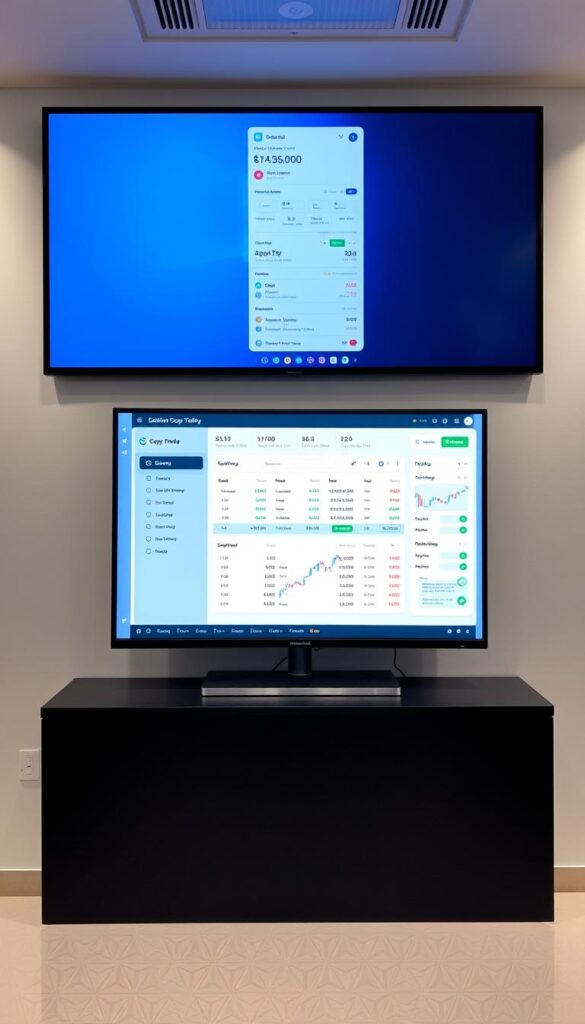Copy Trading 101: A Beginner’s Guide
Investing in yourself is often seen as the best investment. One way to do this is through copy trading. It’s a strategy that’s becoming popular among both new and seasoned traders.
So, what is copy trading? It’s a method where you follow the trades of experienced investors. This way, you can learn from others and possibly earn money, even if you’re new to trading.
In this guide, we’ll look at copy trading as a smart investment strategy. We’ll cover its definition, how it works, and why it’s liked by many traders.
Key Takeaways
- Understanding the basics of copy trading.
- Learning how to choose the right traders to copy.
- Discovering the benefits of copy trading for beginners.
- Exploring how copy trading can be a valuable tool for experienced traders.
- Understanding the potential risks and rewards associated with copy trading.
What is Copy Trading?
Copy trading lets people use the skills of experienced traders. It’s found on sites like Binance. Users can follow the trades of top traders, called lead traders.
Understanding the Basics
Copy trading makes trading easy. It helps new traders use the skills of experts. You pick a lead trader to follow, and the platform does the same trades in your account.
How Copy Trading Works
Copy trading is simple. After picking a lead trader, the platform does the same trades in your account. This happens when the lead trader makes a trade. The trade is done in your account, based on how much you’ve set aside for copy trading.
| Feature | Manual Trading | Copy Trading |
|---|---|---|
| Trader Expertise | Requires personal trading knowledge | Leverages expertise of lead traders |
| Time Commitment | Demands continuous market monitoring | Automates trading based on lead trader’s actions |
| Emotional Stress | High due to personal decision-making | Reduced as decisions are made by lead traders |
In summary, copy trading is a great tool for everyone. It makes trading accessible to all, no matter their experience. By understanding it, people can make better choices about their investments.
Benefits of Copy Trading
Copy trading is great for those new to trading. It lets you use the skills of experienced traders. This can lead to big profits.
Earning Potential for Beginners
One big benefit of copy trading is making money without much work. Beginners can make money without constantly watching the markets. This is perfect for those new to trading or who don’t have time to watch the markets.
Here’s a table showing possible earnings based on different strategies:
| Investment Strategy | Initial Investment | Potential Return |
|---|---|---|
| Copy Trading | $1,000 | 10% |
| Manual Trading | $1,000 | 5% |
| Social Trading | $1,000 | 8% |
Learning from Experienced Traders
Copy trading is more than just copying trades. It’s a great way to learn. Beginners can see how experienced traders work and learn from them. This helps them get better at trading.

Exploring copy trading shows it can open up financial markets to more people. It lets beginners use the knowledge of experienced traders. This makes it easier for anyone to start trading and make money.
The Difference Between Copy Trading and Other Trading Methods
Copy trading is a special way to trade that stands out from traditional methods. It has its own set of benefits and traits.
Copy Trading vs. Manual Trading
Manual trading means traders make their own decisions and manage their trades. Copy trading, on the other hand, copies the trades of experienced traders. This is great for beginners or those who don’t have time to watch the markets all day.
Manual trading needs a lot of knowledge about trading and the market. Copy trading lets you use the skills of others. This is a big help for new traders who don’t know a lot yet.
“Copy trading allows you to benefit from the expertise of successful traders, reducing the need for personal market analysis.”
Copy Trading vs. Social Trading
Copy trading and social trading both involve working with other traders. But they are different. Social trading lets you follow and learn from others but doesn’t copy their trades. Copy trading, however, automatically copies the trades of the traders you follow.
The table below shows the main differences between copy trading, manual trading, and social trading:
| Feature | Copy Trading | Manual Trading | Social Trading |
|---|---|---|---|
| Automation | Automated trade replication | No automation; manual trade execution | No automated trade replication |
| Expertise Required | Low; leverages others’ expertise | High; requires personal market analysis | Variable; can learn from others |
| Interaction with Other Traders | Limited to copying trades | No direct interaction | Active interaction and discussion |
The table shows that copy trading is special because it combines automation with using others’ expertise. This makes it different from manual and social trading.

In conclusion, knowing the differences between copy trading and other methods is key to choosing the right strategy. By understanding what makes copy trading unique, traders can make better choices about how to invest.
How to Get Started with Copy Trading
Starting your copy trading journey means picking a trustworthy platform. There are many options, so it’s important to find one that fits your trading goals. It should also have the tools you need to succeed.
Choosing a Reliable Platform
When picking a copy trading platform, consider a few things. Look for a platform that is easy to use, has strong security, and offers many traders to copy. Reliable platforms like TIOmarkets and Binance are great choices. They provide a smooth experience for users.
Here are some key features to look for:
- Transparent fee structures
- Access to a diverse pool of traders
- Reliable customer support
- Advanced risk management tools

Setting Up Your Account
After choosing a platform, set up your account. This involves registering, verifying your identity, and adding funds. Make sure you understand the platform’s terms and conditions first.
Here’s how to set up your account:
- Create an account on the chosen platform
- Verify your identity as required by the platform
- Deposit funds into your trading account
- Browse and select traders to copy based on their performance
| Platform Features | TIOmarkets | Binance |
|---|---|---|
| User Interface | Intuitive | User-friendly |
| Security Measures | Robust | Advanced |
| Trader Selection | Diverse | Extensive |
By choosing a reliable platform and setting up your account right, you can increase your chances of success in copy trading.
Selecting the Right Traders to Copy
Finding the right traders to copy is key to making money in copy trading. You need to check their past performance and spread out your investments wisely.
Analyzing Trader Performance
When checking a trader’s performance, don’t just look at their past profits. Reliability and consistency show if they can keep doing well. Look at:
- How they’ve done in different market conditions
- How they manage risks
- How often they make trades and how long they hold them
This helps you understand their investment approach and if they can keep succeeding over time.
| Trader Performance Metrics | Description | Importance |
|---|---|---|
| Historical Returns | Past performance of the trader | High |
| Risk Management | Strategies used to mitigate losses | High |
| Trade Frequency | How often the trader executes trades | Medium |
Diversifying Your Investments
Diversifying is crucial in copy trading. By copying many traders with different investment styles and risk profiles, you can lower your risk and boost your chances of making money.
A leading financial expert once said,
“Diversification is the only free lunch in investing.”
This idea is especially true in copy trading. It helps you handle the ups and downs of the market better.

To diversify well, copy traders in different areas and with different levels of experience. This way, you can take advantage of more investment options and possibly get more consistent results.
Risks Involved in Copy Trading
It’s important to know the risks of copy trading before you start. We’ll look at the downsides and how to avoid them.
Market Volatility
Market volatility is a big risk in copy trading. The financial markets can change quickly. Even skilled traders can lose money.
When you copy a trader, you face the same risks. It’s crucial to manage these risks well.
Market volatility can cause sudden changes in your investments. Knowing this risk is key. You need strategies to handle it.

Understanding Risk Management
Risk management is vital for copy trading success. It means setting limits, diversifying, and watching the traders you follow.
- Set stop-loss orders to limit losses.
- Diversify your investments across different asset classes and traders.
- Regularly review the performance of the traders you’re copying and adjust your portfolio as needed.
By understanding and using these copy trading strategies, you can manage risks better. This might help you get better results.
Strategies for Successful Copy Trading
Understanding and using effective strategies is key to successful copy trading. A well-planned approach is crucial for making the most money and reducing risks.
Long-Term vs. Short-Term Strategies
Copy traders can choose between long-term and short-term strategies. Long-term strategies involve copying trades for a long time. This helps you handle market ups and downs and catch long-term trends.
Short-term strategies are about copying trades for a short time. This can help you grab quick market chances.
To see the differences, let’s look at a table:
| Strategy Type | Duration | Risk Level | Potential Return |
|---|---|---|---|
| Long-Term | Several months to years | Moderate | High |
| Short-Term | Days to weeks | High | Moderate to High |
Monitoring and Adjusting Your Portfolio
It’s vital to monitor your portfolio and adjust as needed, no matter your strategy. Keep an eye on the traders you’re copying. Be ready to stop copying if their performance drops.
Regular checks also help you rebalance your portfolio. This keeps your investments in line with your goals and risk level. It can improve your copy trading results.

The Role of Technology in Copy Trading
Technology has changed copy trading a lot. Now, we have many tools and resources to help us trade better. These tools help us make smarter choices and improve our strategies.
Tools and Resources to Enhance Success
The right tools and resources are key to success in copy trading. Copy trading platforms are important because they let traders share and follow strategies. They offer features like tracking performance, managing risks, and connecting with others.
Some important tools on these platforms include:
- Advanced charting and analysis tools
- Real-time performance data
- Risk management features
- Social trading communities
Using these tools helps traders make better choices and adjust their plans.

The Impact of Algorithms and AI
Algorithms and Artificial Intelligence (AI) are making copy trading better. They help platforms analyze lots of data, find patterns, and predict market trends.
Using algorithms and AI brings many benefits, such as:
| Benefit | Description |
|---|---|
| Improved Accuracy | Algorithms can analyze data more accurately and quickly than humans. |
| Enhanced Predictive Capabilities | AI can predict market movements based on historical data and patterns. |
| Real-time Monitoring | Algorithms can monitor markets in real-time, allowing for quicker responses to market changes. |
These technologies give traders an edge and help them trade better.
Regulations and Safety in Copy Trading
Copy trading is overseen by regulatory bodies to protect investors’ funds. It’s important to understand these rules to make smart choices.
Understanding Regulatory Bodies
Regulatory bodies are key in managing copy trading. In the U.S., the Securities and Exchange Commission (SEC) oversees this area. They make sure platforms follow rules to keep investors safe.
“The SEC’s role in regulating copy trading is to maintain fair, orderly, and efficient markets, and to protect investors by ensuring that copy trading platforms are transparent and compliant with regulatory requirements,” as stated by the SEC.
Ensuring Platform Security
Keeping copy trading platforms secure is crucial. Look for platforms with strong security like encryption and two-factor authentication. This keeps your info and money safe.
When picking a platform, check their security and follow rules. Important things to look at include:
- Regulatory compliance and licenses
- Encryption and data protection policies
- Two-factor authentication and account security
- Transparency in trading practices and fees
Choosing a secure and compliant platform reduces copy trading risks. This makes for a safer trading experience.

As copy trading grows, staying up-to-date with rules and security is key. Investors should check copy trading reviews and updates from regulators often. This keeps them safe and in line with the law.
Common Mistakes to Avoid in Copy Trading
To get the most out of copy trading, it’s key to avoid common mistakes. Copy trading makes it easier to get into the financial markets. But, there are traps that can cause big losses if not handled with care.
Overtrading and Emotional Decisions
One big risk in copy trading is overtrading. This happens when you follow too many trades without a solid plan. It’s often driven by emotions, not a clear strategy. Making quick decisions based on feelings can lead to bad choices, like following a popular trader without checking the market.
To avoid overtrading:
- Set clear investment goals and stick to them.
- Diversify your portfolio by copying a variety of traders with different strategies.
- Regularly review your copy trading settings to ensure they remain aligned with your investment objectives.
Neglecting Research and Analysis
Another big mistake is not doing enough research and analysis. Copy trading makes investing easier, but you still need to know who you’re following and their strategies. Not doing this can lead to following a trader blindly, which can cause losses.
Conducting thorough research involves:
- Analyzing the performance history of the traders you intend to copy.
- Understanding the risk management strategies employed by these traders.
- Staying informed about market conditions that could impact the traders’ performance.
To show why avoiding these mistakes is important, let’s look at a comparison of successful and unsuccessful copy trading strategies.
| Strategy | Characteristics | Potential Outcome |
|---|---|---|
| Successful Copy Trading | Diversified portfolio, regular monitoring, thorough research | Consistent returns, managed risk |
| Unsuccessful Copy Trading | Overtrading, emotional decisions, lack of research | Significant losses, unmanaged risk |

The Future of Copy Trading
Looking ahead, copy trading is set to grow with new tech and trends. More people are using it to make money in the markets. This shows how the definition of copy trading is getting broader.
Artificial intelligence and machine learning are big trends in copy trading. They help analyze trader performance and manage risks better.
Emerging Trends
Social trading and combining copy trading with other strategies are also trends. The financial world is changing fast. We’ll see copy trading platforms get more advanced and user-friendly.
Technological Advancements
Blockchain and advanced algorithms will shape copy trading’s future. They’ll make copy trading safer and more efficient. This will attract more people to it.
It’s crucial to keep up with these tech changes. They’ll affect how we see copy trading and the whole industry. Using a good copy trading platform can help traders succeed in this fast-changing field.
FAQ
What is copy trading, and how does it work?
Copy trading lets you follow experienced traders’ moves. It’s great for beginners or those short on time. You can copy trades in real-time.
What are the benefits of using a copy trading platform?
Copy trading platforms connect you with skilled traders. This can diversify your investments and offer passive income. You also learn from lead traders, improving your trading skills.
How do I choose the right traders to copy?
Look at a trader’s past performance and risk management. Also, consider their trading style. Diversify by copying different traders to reduce risk.
What are the risks associated with copy trading?
Copy trading risks include market ups and downs and losses from bad trader decisions. It’s also risky to rely too much on one strategy. Always manage your risk.
How can I manage risk when using copy trading?
Use stop-loss orders and spread your investments. Keep an eye on the traders you follow. Adjust your portfolio to match your goals.
What is the difference between copy trading and social trading?
Copy trading automatically follows lead traders’ trades. Social trading shares insights but lets you make your own decisions. It’s about following versus sharing.
Are there any regulations governing copy trading?
Yes, copy trading has rules that vary by place. Know the laws in your area and choose a compliant platform.
How does technology impact copy trading?
Tech improves copy trading with better algorithms and AI. It also offers tools like analytics and risk software. This makes trading more efficient.
What are some common mistakes to avoid in copy trading?
Avoid overtrading and emotional decisions. Don’t skip research and analysis. Be careful not to rely too much on one trader or strategy.
What does the future hold for copy trading?
Copy trading’s future will be shaped by tech and laws. Expect new tools and platforms. This could make investing more sophisticated and accessible.
The post Copy Trading 101: A Beginner’s Guide first appeared on ItsAndroidzilla.
source https://itsandroidzilla.com/android/copy-trading-101-a-beginners-guide/
Comments
Post a Comment